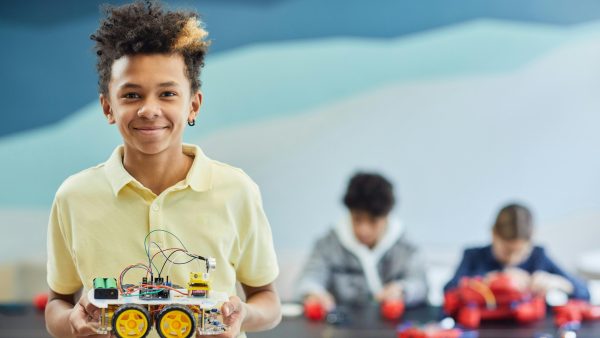Innovation is not limited to technology, as is often mistakenly thought. In today’s world, we face challenges in areas such as health, education and the environment, all of which require creative solutions. Other important skills include initiative, the ability to take calculated risks, and the ability to evaluate and assess. These skills are fundamental to thriving in the age of innovation, which differs significantly from the knowledge economy of the industrial age.
Against this background, the question arises: Is the current education system sufficiently prepared to provide this kind of training?
The power of collaboration in schools
Traditional schools, following a conventional approach, tend to focus on individual student achievement, setting rewards and assessments to measure the progress of individual students. However, the reality of innovation shows that this one-sided approach is not enough. True innovation emerges from a collaborative effort, where the synergy between different individuals and their complementary skills plays a fundamental role.
In a collaborative environment, ideas are nurtured, expanded and refined through the exchange of diverse perspectives and experiences. It is in this cooperative environment that true creativity flourishes and innovative solutions to complex challenges are generated. It is therefore crucial that schools recognise the importance of fostering collaboration among students as an integral part of their educational process, thus preparing them for the real world where innovation and teamwork are essential for success.
Promoting interdisciplinarity in education
Traditional schools often adopt a structure that segments knowledge into different disciplinary areas, promoting specialisation in specific fields. While specialisation has its value and place in education, the reality is that we live in an era where the challenges we face do not fit within the narrow confines of a single academic discipline.
Innovation, by its very nature, transcends disciplinary boundaries and emerges from the intersection of diverse areas of knowledge. The complex problems we face in today’s world require holistic approaches that integrate perspectives and methodologies from multiple disciplines. From climate change to healthcare, from technology to social justice, each challenge demands interdisciplinary understanding and innovative solutions that harness the diversity of approaches.
It is therefore critical that schools recognise the importance of fostering an interdisciplinary mindset among students, providing them with opportunities to explore and connect different areas of knowledge. Doing so not only prepares students to address real-world challenges more effectively, but also empowers them to be critical and creative thinkers who can adapt and thrive in an ever-changing environment.
Cultivating critical and creative thinking
In the culture of innovation, individual initiative is valued and constructive questioning is encouraged. Here, it is recognised that true creativity and progress emerge when pre-established ideas are challenged and new perspectives are explored. In this environment, students are encouraged to engage in problem solving, encouraging them to find innovative solutions through lateral thinking and experimentation.
It is crucial that 21st century classrooms reflect this mindset of innovation, providing a space where students feel free to express their ideas and to collaborate in finding solutions. Cultivating an environment that promotes initiative and questioning prepares students to face real-world challenges with confidence and creativity.
Failure as a driver of growth in school
Fear of failure represents one of the most significant barriers in the educational context. Both teachers and students often avoid taking risks because of an inherent fear of failure. This aversion to failure is rooted in the culture of traditional schools, where error is seen as something negative, something to be avoided at all costs. However, in the age of innovation, failure is perceived differently.
Innovation inevitably requires learning from mistakes and taking calculated risks in order to move forward. Failures are not seen as insurmountable obstacles, but as opportunities for learning and growth. In an educational environment that fosters a culture of innovation, students are encouraged to experiment, try new ideas and take on challenges, knowing that failure is part of the learning process and that every mistake is an opportunity to improve.
It is essential that schools create an environment where fear of failure is replaced by confidence in oneself and in the learning process. Students should feel confident to take risks and face challenges, knowing that every experience, whether a success or a failure, will provide valuable lessons that will help them grow and develop into creative and resilient individuals.
Transforming motivation in schools
In relation to motivation, it is common for schools to rely on external incentives, such as rewards and punishments, to boost student performance. However, in today’s era of innovation and constant change, there is a significant shift in what motivates young people.
Beyond simple material rewards or threats of punishment, students are increasingly motivated by the possibility of making a meaningful contribution and making a difference in the world around them. This new generation seeks a deeper purpose in their education and in their actions. They yearn to be involved in projects that have a positive impact on society, that address real problems and that promote change and innovation.
In this sense, schools are adapting to this new motivational reality by providing opportunities for students to engage in collaborative projects that address important challenges and allow them to apply their knowledge in practical and meaningful ways. Encouraging their participation and commitment to causes that transcend the individual nurtures young people’s intrinsic motivation and paves the way for them to become agents of change and innovative leaders in the future.
Towards a new educational paradigm: innovation, creativity and equity
In summary, the above contradictions highlight the crucial challenges we face in trying to transform education in the age of innovation. It is important to address the creation of a new educational paradigm that is truly holistic and adaptable to the demands and challenges of today’s world.
This new education system must be designed with the interconnectedness of 21st century skills, the fostering of creativity and critical thinking, as well as the promotion of collaboration and innovation in mind. It must be inclusive and equitable, ensuring that every individual has access to quality educational opportunities, regardless of their background or circumstances.
Furthermore, this new education system must be constantly evolving and adapting, in tune with the rapid technological, social and economic changes that characterise our era. This implies greater flexibility in teaching and assessment methods, as well as greater attention to continuing education and professional development of teachers.
Ultimately, the creation of this new education system requires not only the collaboration of educators and public institutions, but also the participation of society as a whole. Only through a collective effort and a genuine commitment to educational transformation can we ensure that our schools prepare future generations to meet the challenges and seize the opportunities of a changing world.








